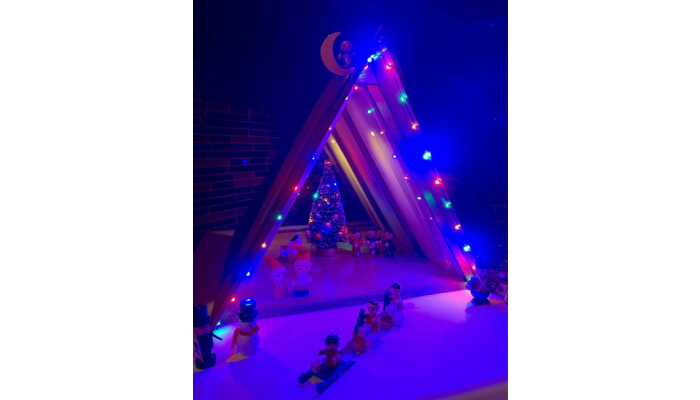
Small Battery LED Lights: What Makes Them Different?
Small battery LED lights stand out mainly because they combine compact size with energy efficiency, making them perfect for small or portable projects. Powered by batteries like coin cells (CR2032, CR1225), AAA, or AA types, these LEDs run cool and consume very little power compared to traditional bulbs. Coin cells are ideal for tiny spaces but only support a few LEDs at full brightness, while AA or AAA batteries provide longer runtimes suitable for multiple lights. Their different shapes and colors add versatility, and simple circuitry can create special effects like flashing. Overall, their portability and low heat generation make them well-suited for models, costumes, and small gadgets where larger lighting options won’t fit.
What Are Small Battery LED Lights?
Small battery LED lights are compact lighting units powered by batteries such as coin cells (like CR2032), AAA, AA, or 9V types. They are designed to fit into tight spaces and provide portable illumination where traditional power sources aren’t practical. These lights use energy-efficient LEDs that consume very little power while delivering bright, cool light, which helps prevent heat buildup and protects delicate materials or electronics. Commonly found in hobby models, wearable tech, and small gadgets, small battery LED lights offer a cordless and easy-to-install solution. Their standardized battery sizes make replacements straightforward, and their low voltage and current requirements add a layer of safety, making them popular for DIY projects. Available in various shapes, sizes, and colors, these lights are versatile enough for both simple and decorative uses where space and power are limited.
Types of Batteries Used with Small LED Lights
Small battery LED lights rely on various battery types, each suited to different needs and designs. Coin cell batteries like the CR2032 and CR1225 are favored for ultra-compact setups due to their small size and 3V output. However, they have limited current capacity, typically powering up to about 10 LEDs at full brightness before draining within a few hours. For projects needing longer runtimes or multiple LEDs, AA and AAA batteries are common choices. These 1.5V cells provide higher current and extended battery life, often lasting many times longer than coin cells in the same circuit. When higher voltages are required, such as for special flashing effects or sirens, 9V batteries come into play, offering compact size with increased voltage output. Rechargeable options like NiMH or lithium-ion batteries are also used in some LED setups, bringing benefits like reusability and higher energy density, which can be especially useful in portable or frequently used devices. Selecting the right battery impacts not only brightness and runtime but also the overall circuit design, since matching the battery voltage with the LED requirements and including appropriate current regulation is key to efficient performance. Standard household batteries remain popular because they are easy to find and replace, simplifying maintenance. Ultimately, battery choice depends on the number of LEDs, desired brightness, and usage patterns, balancing size, power, and longevity.
How Design and Technology Set Them Apart?
Small battery LED lights stand out mainly because of the advances in micro-LED technology. These tiny LEDs are extremely energy efficient, consuming minimal power while still producing bright light. Unlike incandescent or halogen bulbs, they generate very little heat, making them safer and more suitable for delicate or portable projects like models or costumes. Their sizes range from pico to nano LEDs, allowing them to fit in almost any space without compromising brightness. The ability to produce various colors, including red, green, blue, white, and even color-changing effects, adds versatility for both functional and decorative uses. Many small battery LED lights include simple circuits with resistors or driver chips that regulate current and enable features like flashing or flickering, which can enhance the visual appeal without draining the battery quickly. The shape and size of these LEDs can be customized to match specific design needs, giving creators more freedom to integrate lighting seamlessly. Improvements in LED driver technology also contribute by maintaining steady light output and maximizing battery life, which is crucial when working with compact power sources like coin cells or AA batteries. Overall, the combination of miniaturization, low power consumption, flexible design, and smart circuitry distinguishes small battery LED lights from traditional lighting options, making them ideal for projects where space, power, and heat management are critical.
Benefits Compared to Other Lighting Options
Small battery LED lights offer several advantages over traditional lighting options like incandescent bulbs or larger plug-in LEDs. One of the biggest benefits is their long lifespan; LEDs can last thousands of hours, far outlasting incandescent bulbs that burn out quickly. Their low energy consumption means batteries run much longer before needing replacement, which reduces both cost and hassle. Because LEDs generate very little heat, they avoid damage to sensitive materials, making them ideal for models, crafts, or costumes that can’t handle heat buildup. The use of common batteries such as AA, AAA, or coin cells makes replacements easy and affordable, while the cordless design allows these lights to be used anywhere, regardless of power outlet availability. Their small size and tough construction also mean they fit into compact or hidden spaces and are much less likely to break compared to fragile glass bulbs. Plus, LEDs reach full brightness instantly without any warm-up time, and they require less maintenance since there’s no frequent bulb replacement. The wide variety of LED types and battery options lets users choose the perfect combination for their specific needs, whether it’s steady illumination, flashing effects, or color options, making small battery LED lights a versatile and practical choice in many applications.
Common Uses for Small Battery LED Lights
Small battery LED lights find their place in many creative and practical applications where space and power are limited. Hobbyists often use them to illuminate model train sets, dollhouses, and miniature vehicles, adding realistic lighting without bulky wiring. In the world of costumes and cosplay, these tiny LEDs create hidden lighting effects that bring designs to life while remaining lightweight and comfortable to wear. Crafters incorporate them into small projects or event displays to provide subtle light accents that enhance visual appeal without overpowering the design. Portable devices like drones, remote control vehicles, and wearable technology rely on small battery LEDs for efficient lighting that keeps weight down and runtime high. During holidays, when power cords are inconvenient or unwanted, these LEDs brighten decorations safely and easily. Small battery LED lights also serve as signal lights and indicators in gadgets and DIY electronics, helping users monitor status or alerts. Compact flashlights and keychain safety lights use these LEDs for emergency illumination, offering reliable brightness in a small form factor. Architects and artists employ them as accent lighting in miniature models to highlight details and improve presentation. Backlighting buttons or switches in portable equipment often depends on these LEDs to provide clear visibility without adding bulk. Additionally, educational kits use small battery LEDs to teach electronics and lighting basics, giving learners hands-on experience with simple, low-power circuits.
Choosing the Right Small Battery LED Light
Selecting the right small battery LED light starts with understanding the space available for both the LED and its battery. Compact projects like wearable tech or miniature models often require coin cells, such as CR2032 or CR1225, because of their tiny size. However, these batteries have limited capacity and can only power a few LEDs at full brightness. If your project needs more brightness or longer runtime, consider AA or AAA batteries, which offer higher current and longer life but take up more space. Next, calculate the total power consumption based on the number of LEDs and their brightness needs. Matching the battery voltage closely to the LED’s forward voltage is crucial to avoid dim lighting or damage. For example, a 3V coin cell pairs well with a 3V LED, but using a 9V battery without proper regulation can burn out the LED quickly. Incorporating appropriate resistors or driver circuits helps regulate current safely and can enable special effects like flashing or flickering, which may also affect battery life. Consider how often you want to replace batteries: coin cells may last only a few hours under heavy use, while alkaline AA batteries can run for many times longer. If the light will be worn or carried, factor in weight and size to keep it comfortable. Finally, check compatibility with any existing electronics to ensure smooth integration. Ease of battery replacement and the availability of replacement batteries also matter, especially for portable applications. Balancing these factors helps you pick a small battery LED light that fits your project’s needs without sacrificing performance or convenience.
Popular Battery Technologies for Small LEDs
Alkaline batteries are one of the most common choices for small LED lights thanks to their affordability and easy availability. They are non-rechargeable and work well for moderate power needs, such as powering a few LEDs in a costume or decorative item. However, their voltage tends to drop steadily as they discharge, which can affect LED brightness over time. Lithium-ion batteries bring a different strength to the table. These rechargeable batteries offer high energy density, meaning they can power high-performance LED lights for longer periods without adding much bulk. Their stable voltage output helps maintain consistent brightness, but they require proper charging circuits to ensure safety and battery longevity. Nickel-metal hydride (NiMH) batteries are another rechargeable option, known for being more environmentally friendly than alkalines. They hold charge better over time with moderate self-discharge rates and provide reliable current for small LED setups. While lead-acid batteries power larger LED systems, they are rarely used in small battery LEDs due to their size and weight. Coin cells, usually based on lithium chemistry, are perfect for ultra-compact LED applications where space is tight. Though they supply limited current, their compact form factor makes them ideal for wearable LEDs or small gadgets. The choice of battery chemistry not only affects size and weight but also influences voltage stability and discharge curves, which in turn impacts how bright the LEDs shine throughout their use. It’s also important to consider environmental disposal and recycling options, as rechargeable batteries like NiMH and lithium-ion tend to be more eco-friendly over time compared to alkaline and coin cells. Overall, matching the battery type with the LED’s power needs, size constraints, and user priorities is key to getting the best performance from small battery LED lights.
- Alkaline batteries are common, affordable, non-rechargeable, suited for moderate power needs.
- Lithium-ion batteries offer high energy density and rechargeability for high-performance lights.
- Nickel-metal hydride (NiMH) batteries are rechargeable and environmentally friendlier than alkaline.
- Lead-acid batteries are not typical for small LED lights but used in larger stationary LED systems.
- Coin cells are typically lithium chemistry, providing compact power with limited current.
- Battery chemistry impacts voltage stability and discharge curves affecting LED brightness.
- Rechargeable battery types require appropriate charging circuits to maintain safety.
- Battery weight and size vary by technology, influencing portability.
- Self-discharge rates differ: lithium-ion and NiMH retain charge better over time than alkaline.
- Consider environmental disposal and recycling options for different battery types.
How Battery Life Varies with LED Type and Usage?
Battery life in small battery LED lights depends heavily on the type of LED used and how it’s operated. Connecting more LEDs in a circuit increases power draw, which shortens battery runtime. For example, running 10 LEDs on a CR2032 coin cell might only last around 3.5 hours, but the same setup with AA batteries can extend that to about 80 hours. Flashing or flickering LEDs usually consume more energy than steady-lit ones because their circuitry often requires additional power to create the effect. Similarly, higher brightness LEDs draw more current; a bright white LED will drain a small battery faster than a dimmer red one. Battery capacity matters too, AA or AAA batteries have higher capacity than coin cells, so they support longer usage and more LEDs. The way batteries discharge also affects how consistently the LEDs shine over time; as voltage drops, LEDs may dim or flicker, so replacing batteries before they get too weak helps maintain steady light. Environmental factors like temperature and usage conditions influence battery efficiency and lifespan, with cold temperatures generally reducing battery performance. Efficient current regulation in the LED circuit can preserve battery life by preventing unnecessary power waste, and some LEDs have built-in drivers designed to optimize power consumption. When calculating battery life, considering the LED duty cycle and usage patterns is important, a flashing LED that’s on only half the time will last longer than one that’s constantly lit. Overall, understanding these factors helps in selecting the right LED and battery combination to balance brightness, effect, and runtime for your specific project.



